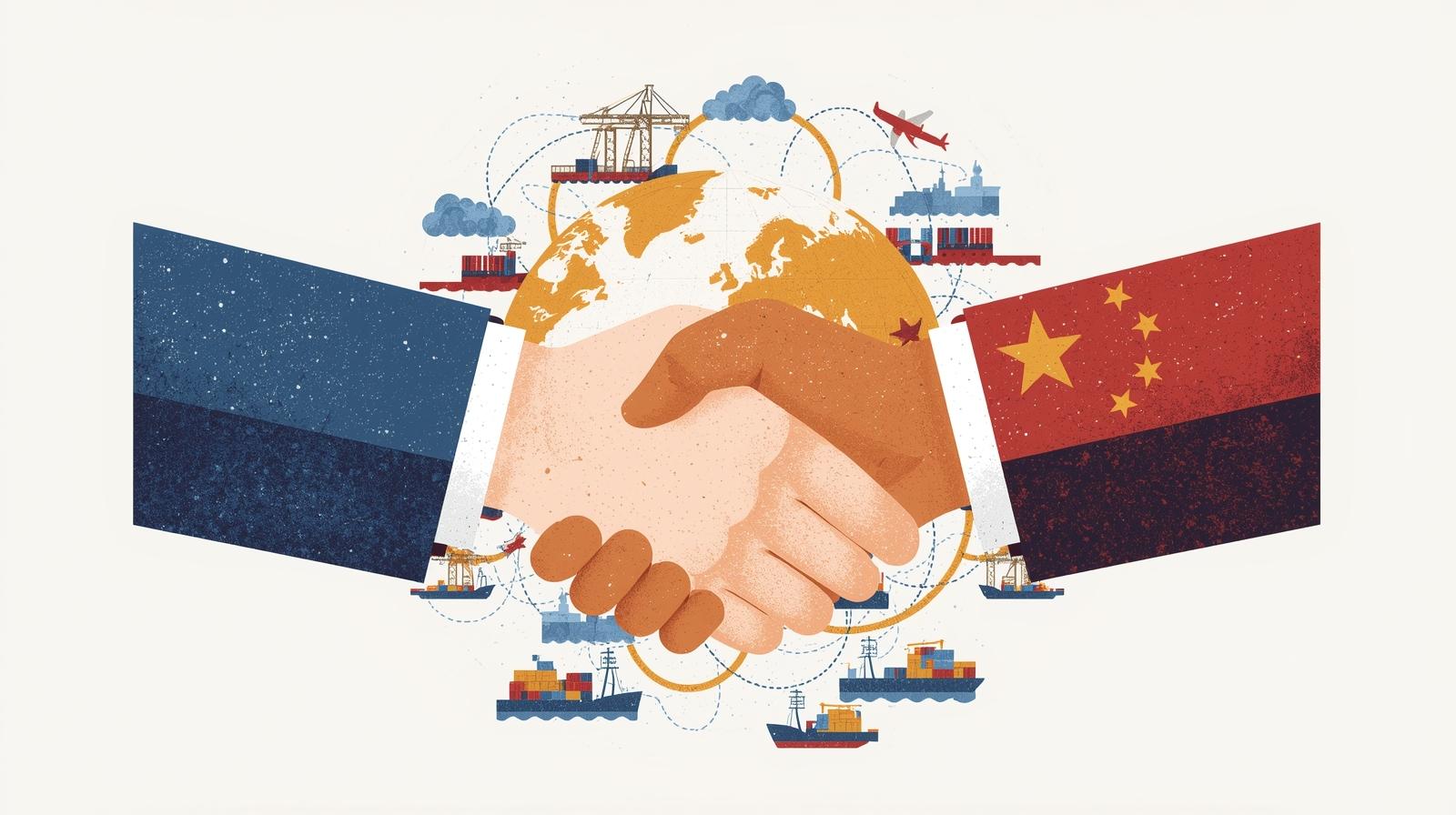Author: Maria Pechurina, Director of International Trade @ Peacock Tariff Consulting
The current state of international trade between the U.S. and China is marked by ongoing negotiations, product and company-specific investigations, tariff impositions and attempts to secure mutual concessions. The arrangements are ever-evolving and the legal challenges like the IEEPA lawsuit create additional complexity. We aim to provide some insight into the recent environment and strategic developments impacting bilateral commerce.
The Negotiation Landscape
The recent round of the U.S.–China trade negotiations have focused on reducing retaliatory tariffs, exploring possible concessions, and advancing specific deals such as the resolution of disputes around TikTok and an agreement for major purchases of US aircraft.
Note: China is likely biding its time until they develop a competing domestic aircraft and then will pressure countries within the realm of their political influence to purchase accordingly
The TikTok deal, which requires the application’s divestment from ByteDance to a U.S. bidder in order to avoid a ban in the United States, has become both a political and trade flashpoint in U.S.-China relations. For Washington, the agreement balanced national security concerns with electoral politics, as Trump leveraged TikTok’s youth user base to secure support in the 2024 election, turning a potential liability into a campaign asset. For Beijing, conceding on divestment underscored the reach of U.S. regulatory power but allowed China to preserve trade negotiations by using the deal as a bargaining chip tied to tariffs, technology policy, and broader economic concessions. As a result, TikTok has emerged not only as a symbol of digital sovereignty and generational politics but also as a precedent-setting tool in U.S.-China trade talks, where technology platforms are now explicitly linked to tariff and economic diplomacy. TikTok USA 45% share will be owned by Oracle, Silver Lake and MGX (Abu Dhabi), while ByteDance will own 19.9%; the remainder (about 35%) will be redistributed among ByteDance investors and new shareholders.
End of current tariff pause: November 10th
Rounds of trade negotiations completed in 2025: 4, Geneva, London, Stockholm, and Madrid
Prediction: The pause will be extended for an additional ~ 6 months as both sides seek to gain leverage in key issues like China’s control of Rare Earth Magnets and other critical components, China & US export controls, China’s Anti-Foreign Sanctions Law and China’s purchases of US Chips).
The Tariff Environment
Since the start of the Trump administration’s first term, tariffs between the U.S. and China have surged, with both countries imposing elevated rates on bilateral exports far above those applied to the rest of the world. Data shows sharp increases in rates since 2018 (Trump 1.0), with around 80–100% of bilateral trade now subject to tariffs, compared to far lower shares earlier in the decade. This escalation reflects a pattern of tit-for-tat policy moves, pushing average rates on key exports well above multilateral norms.
The ongoing issues, such as tariff circumvention through transhipment, structural market access to China, and the semiconductor industry’s exposure to additional regulatory scrutiny, all add layers of complexity to this already tedious dialogue, marked by differences in political systems, culture and business practices.
Long-term challenges remain for both parties as they seek to reconcile market access and regulatory alignment with their strategic interests, but when cutting through the post-liberation-day tariff noise, we hold that the situation with China is not as bad as it may seem – held at 34% in the absence of a deal, China tariffs (exemptions apply) are not even the highest among all US trading partners.
Product-Specific Investigations:
Key products under Section 232 (of the trade expansion act of 1962) investigation include lumber, integrated circuits, pharmaceuticals, semiconductors, commercial aircraft, and wind turbines, among others. These investigations reflect U.S. concerns of perceived vulnerabilities in supply chains and strategic sectors, targeting categories that have been at the heart of recent disputes and protective measures. Steel & Aluminum Tariffs, calculated based on the value of content, range from 50% on China to 25% on UK products.
Tariff Structures & The Rise in Unconventional Trade Agreements
Asia-Pacific tariff rates break down into preferential, standard, and non-deal categories. Countries like Japan and Korea, which have preferential deals with the U.S., driven by substantial investment commitments, face lower reciprocal rates, while China and India, countries with no deals to speak of, face higher rates. For standard trade deals, tariff reductions are tied to commitments such as purchase pledges, investment quotas, and efforts to curb transshipment abuse. Notably, Vietnam and Indonesia have agreed to reduce reciprocal tariffs and cooperate on deeper market and security issues. Deals with Japan ($550 billion commitment) and Korea ($350 billion) feature substantial investment and purchase commitments, including hundreds of billions of dollars for U.S. energy, agricultural, and manufactured goods, as well as expanded market access for U.S. automotive and pharmaceutical products, contrasting sharply with the more contentious environment facing trade with China. However, South Korea was not immune from added scrutiny, as evident from the Hyundai plant raid in Georgia, where ICE detained and arrested almost 500 workers. The workers were highly skilled and were staying in the US legally on ESTA, B-1 and B-2 visas; needless to say, this move by the US has soured the US-Korea relationship already strained due to the pressure exerted by the US on Korea for a $350 billion USD investment in US infrastructure, paid up front, partially in cash. The Japan bilateral agreement outlines a $550 billion investment into critical American industries with the aim of job creation, manufacturing expansion, and reinforcing supply chain resilience, particularly in semiconductors, pharmaceuticals, metals, critical minerals, shipbuilding, energy (including pipelines) and artificial intelligence/quantum computing.
India as a Trade Comparator
The tariff story extends beyond China, with U.S. rates on Indian goods currently standing at 50%, split between reciprocal retaliation and a secondary penalty linked to India’s purchases of discounted Russian oil. As with China, trade penalties reflect a mix of economic and geopolitical factors. Read more on India here. The recent move to dramatically raise the cost of H1B visas to 100 thousand USD will disproportionately affect Indian high-skilled workers (recipients of 70% of H1B’s in 2024) and can be perceived as another tit-for-tat move in the US-India trade talks.
Legal Landscape
Recent court cases challenge the legal basis of certain tariffs, especially those imposed under the International Emergency Economic Powers Act (IEEPA). The case, brought by several Democratic-led states and businesses, represents a major test of presidential power as the tariffs continue to disrupt global trade and economic stability. Trump has defended the tariffs as necessary to address trade deficits and combat drug trafficking, using them as a central foreign policy and economic tool since returning to office in January. The U.S. Supreme Court will hear arguments on November 5 over the legality of President Trump’s use of IEEPA to impose tariffs, which lower courts ruled exceeded his authority. The November 5th hearing is expected to shed some light on the situation, but many experts hold that tariffs are here to stay; the Trump administration has multiple legal “hammers” available and can pivot between them as needed to maintain its preferred tariff regime. If the courts strike down the Reciprocal Tariffs, the White House still has several alternative options to impose new duties, such as Section 232 national security tariffs, Section 301 tariffs for unfair trade practices, Section 338 tariffs for retaliatory measures, and Section 122 for short-term surcharges targeting balance-of-payments crises. Each of these authorities has distinct legal requirements and limitations, but all could be used to quickly revive tariff revenue streams if needed.
Conclusion
The bilateral trade relationship between the U.S. and China remains fraught, with high tariffs and regulatory barriers complicating flows of goods, capital, and technology. Negotiations continue to address retaliation, structural reforms, and protective measures, but the environment for U.S.-China trade remains volatile and is observed cautiously by industry leaders and policymakers alike. While the TikTok deal and other product-specific disputes show that incremental progress is possible, the deeper issues of strategic competition, supply chain security, and technology governance will continue to define the next phase of talks. Both sides are testing the limits of leverage, with the U.S. using tariffs and investment restrictions to exert pressure, and China relying on state-directed markets, and control over the rare earth supply. The outcome will not hinge on one deal or tariff cycle but on whether either side can carve out a sustainable framework that balances economic interdependence with national security concerns. Until then, the U.S. – China trade relationship will remain transactional, uneven, and a driver of global uncertainty that companies must navigate with caution.

